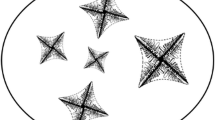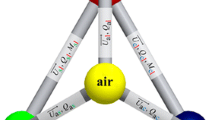A new computational model for predicting microporosity in aluminum alloys is described. The model was calibrated against literature data for binary Al-7 pct Si alloys, and subsequently applied to a chill plate test casting in A356 alloy and to an engine block in 319 alloy. The new model allows spherical micropores to nucleate and grow by hydrogen diffusion from a material volume surrounding the pores. This differs from a conventional interdendritic flow computational model for calculating porosity that assumes spherical pores have a diameter proportional to the secondary dendrite arm spacing (SDAS). The new integrated pore growth and interdendritic flow model predicts larger pore diameters and a volume fraction of microporosity that is in better agreement with experimental observations than the interdendritic flow model.
Similar content being viewed by others
References
Wang Q.G., Apelian D., Lados D.A. (2001) . J. Light Met., 1:73–84
Lee P.D., Chirazi A., See D. (2001) . J. Light Met. 1:15–30
D. Stefanescu: Shape Casting: The John Campbell Symp., TMS, Warrendale, PA, 2005, pp. 295-304.
Lee Y.W., Chang E., Chieu C.F. (1990) . Metall. Trans. B 21:715–722
Suri V.K., Paul A.J., El’Kaddah N., Berry J.T. (1994) . AFS Trans. 102:861–867
S. Viswanathan, A.S. Sabau, Q. Han, A.J. Duncan, W.D. Porter, and R.B. Dinwiddie: Report No. 94-0319, Oak Ridge National Laboratory, Oak Ridge, TN, 2001.
Kubo K., Pehlke R.D. (1985) . Metall. Trans. B 16:359–66
Q.T. Fang and D.A. Granger: Light Metals, TMS, Warrendale, PA, 1989, pp. 927-935.
Atwood R.C., Sridhar S., Zhang W., Lee P.D. (2000) . Acta Mater. 48:405–417
Rappaz M., Gandin C.-A. (1993) . Acta Metall. Mater. 41:345–359
Huang J., Mori T., Conley J.G. (1998) . Metall. Trans. B 29:1249–1260
Atwood R.C., Lee P.D. (2002) . Metall. Mater. Trans. B 33:209–221
Atwood R.C., Lee P.D. (2003) . Acta Mater. 51:5447–5466
Lee P.D., Chirazi A., Atwood R.C., Wang W. (2004) . Mater. Sci. Eng., A 365:57–65
Hamilton R.W., See D., Butler S., Lee P.D. (2003) . Mater. Sci. Eng., A 343:290–300
Walker M. (2004) Draft Internal GMR Report. GM, Detroit, MI
Poirier D.R., Sung P.K. (2001) Report No. AS-7012. Sandia National Laboratories, Albuquerque, NM
Q. Wang and D. Apelian: ACRL Report No. 97A/PR97-4, ACRL, Metal Processing Institute, Worcester Polytechnic Institute, Worcester, MA, 1997.
E.F. Ryntz: GM Research Report No. MR-844, GM, Detroit, MI, 1984.
Pandat (PanAluminum): Phase Diagram Calculation Software for Aluminum Alloys, Computherm LLC, Madison, WI, 2004.
Emadi D., Gruzleski J.E., Toguri J.M. (1993) . Metall. Trans. B 24:1055–1063
G. Backer: http://www.wrafts.com, Flow Logic, Southfield, MI, 2006.
Author information
Authors and Affiliations
Corresponding author
Additional information
This article is based on a presentation made in the symposium “Simulation of Aluminum Shape Casting Processing: From Design to Mechanical Properties,” which occurred March 12–16, 2006, during the TMS Spring Meeting in San Antonio, Texas, under the auspices of the Computational Materials Science and Engineering Committee, the Process Modeling, Analysis and Control Committee, the Solidification Committee, the Mechanical Behavior of Materials Committee, and the Light Metal Division/Aluminum Committee.
Rights and permissions
About this article
Cite this article
Backer, G., Wang, Q.G. Microporosity Simulation in Aluminum Castings Using an Integrated Pore Growth and Interdendritic Flow Model. Metall Mater Trans B 38, 533–540 (2007). https://doi.org/10.1007/s11663-007-9049-y
Published:
Issue Date:
DOI: https://doi.org/10.1007/s11663-007-9049-y




